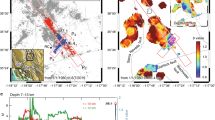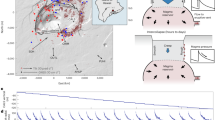Abstract
Stress changes in the Earth's crust are generally estimated from model calculations that use near-surface deformation as an observational constraint. But the widespread correlation of changes of earthquake activity with stress1,2,3,4,5 has led to suggestions that stress changes might be calculated from earthquake occurrence rates obtained from seismicity catalogues. Although this possibility has considerable appeal, because seismicity data are routinely collected and have good spatial and temporal resolution, the method has not yet proven successful, owing to the nonlinearity of earthquake rate changes with respect to both stress and time. Here, however, we present two methods for inverting earthquake rate data to infer stress changes, using a formulation for the stress- and time-dependence of earthquake rates6. Application of these methods at Kilauea volcano, in Hawaii, yields good agreement with independent estimates, indicating that earthquake rates can provide a practical remote-sensing stress meter.
This is a preview of subscription content, access via your institution
Access options
Subscribe to this journal
Receive 51 print issues and online access
$199.00 per year
only $3.90 per issue
Buy this article
- Purchase on Springer Link
- Instant access to full article PDF
Prices may be subject to local taxes which are calculated during checkout




Similar content being viewed by others
References
Simpson, R. W. & Reasenberg, P. A. Earthquake induced stress changes on central California faults. US Geol. Surv. Prof. Pap. 1550-F, 55–89 ( 1994).
King, G. C. P., Stein, R. S. & Lin, J. Static stress changes and the triggering of earthquakes. Bull. Seismol. Soc. Am. 84, 935– 953 (1994).
Jaumé, S. C. & Sykes, L. R. Evolution of moderate seismicity in the San Francisco Bay region, 1850 to 1993: Seismicity changes related to the occurrence of large and great earthquakes. J. Geophys. Res. 101, 765–789 (1996).
Harris, R. A., Simpson, R. W. & Reasenberg, P. A. Influence of static stress changes on earthquake locations in southern California. Nature 375, 221–224 (1995).
Stein, R. S. The role of stress transfer in earthquake occurrence. Nature 402, 605–609 (1999).
Dieterich, J. H. A constitutive law for rate of earthquake production and its applications to earthquake clustering. J. Geophys. Res. 99, 2601–2618 (1994).
Dieterich, J. H. & Kilgore, B. Implications of fault constitutive properties for earthquake prediction. Proc. Natl Acad. Sci. USA 93, 3787–3794 (1996).
Scholz, C. H. Earthquakes and friction laws. Nature 391, 37–42 (1998).
Stein, R. S., Barka, A. A. & Dieterich, J. H. Progressive failure on the North Anatolian fault since 1939 by earthquake stress triggering. Geophys. J. Int. 128, 594–604 (1997).
Linker, M. F. & Dieterich, J. H. Effects of variable normal stress on rock friction: observations and constitutive equations. J. Geophys. Res. 97, 4923–4940 (1992).
Delaney, P. T., Miklius, A., Arnadottir, T., Okamura, A. & Sako, M. Motions of Kilauea volcano during sustained eruption from the Puu Oo and Kapaianaha vents, 1983-1991. J. Geophys. Res. 98, 17801–17820 ( 1993).
Owen, S. P. et al. Rapid deformation of the south flank of Kilauea volcano, Hawaii. Science 267, 1328–1332 (1995).
Delaney, P. T., Fiske, R. S., Miklius, Okamura, A. & Sako, M. Deep magma body beneath the summit and rift zones of Kilauea volcano. Science 247, 1311– 1316 (1990).
Gillard, D., Rubin, A. M. & Okubo, P. Highly concentrated seismicity caused by deformation of Kilauea's deep magma system. Nature 384, 343–346 (1996).
Dvorak, J. J. et al. Mechanical response of the south flank of Kilauea volcano, Hawaii, to intrusive events along the rift zones. Tectonophysics 124, 193–209 ( 1986).
Dieterich, J. H. Growth and persistence of Hawaiian volcanic rift zones. J. Geophys. Res. 93, 4258–4270 ( 1988).
Ando, M. The Hawaiian earthquake of November 29, 1975: Low dip angle faulting due to forceful injection of magma. J. Geophys. Res. 84, 7616–7626 (1979).
Got, J., Fréchet, J. & Klein, F. W. Deep fault plane geometry inferred from multiplet relative relocation beneath the south flank of Kilauea. J. Geophys. Res. 99, 15375–15386 ( 1994).
Klein, F. W., Koyanagi, R. Y., Nakata, J. S. & Tanigawa, W. R. The seismicity of Kilauea's magma system. US Geol. Surv. Prof. Pap. 1350, 1019–1185 ( 1987).
Cayol, V. & Cornet, F. H. 3D mixed boundary elements for elastostatic deformation field analysis. Int. J. Rock Mech. Min. Sci. 34, 275–287 ( 1997).
Cayol, V., Dieterich, J. H., Okamura, A. T. & Miklius, A. High rates of deformation prior to the 1983 Eruption of Kilauea Volcano, Hawaii. Science 288, 2343–2346 (2000).
Acknowledgements
We thank A. Rubin for useful suggestions for this manuscript.
Author information
Authors and Affiliations
Corresponding author
Rights and permissions
About this article
Cite this article
Dieterich, J., Cayol, V. & Okubo, P. The use of earthquake rate changes as a stress meter at Kilauea volcano . Nature 408, 457–460 (2000). https://doi.org/10.1038/35044054
Received:
Accepted:
Issue Date:
DOI: https://doi.org/10.1038/35044054
This article is cited by
-
Deformation, seismicity, and monitoring response preceding and during the 2022 Fagradalsfjall eruption, Iceland
Bulletin of Volcanology (2023)
-
Forecasting induced seismicity in Oklahoma using machine learning methods
Scientific Reports (2022)
-
Seismotectonic analysis of the Anker area, Kunene region north-western Namibia
Journal of Seismology (2022)
-
Application and discussion of statistical seismology in probabilistic seismic hazard assessment studies
Science China Earth Sciences (2022)
-
Cyclical geothermal unrest as a precursor to Iceland’s 2021 Fagradalsfjall eruption
Nature Geoscience (2022)
Comments
By submitting a comment you agree to abide by our Terms and Community Guidelines. If you find something abusive or that does not comply with our terms or guidelines please flag it as inappropriate.



